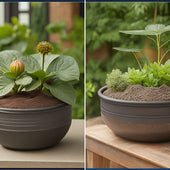
3 Best Rooftop Garden Ideas for Natural Insulation
Share
You can create a rooftop garden that's not only visually stunning but also provides natural insulation, reducing energy consumption by up to 25%. To maximize energy efficiency gains, incorporate native plants that absorb water and cool the air through evapotranspiration. By designing a habitat for local wildlife, you'll attract pollinators and support biodiversity. Additionally, a rooftop garden can mitigate the urban heat island effect, keeping your building cooler and more comfortable. As you explore the possibilities of rooftop gardens, you'll discover even more innovative ways to enhance your building's sustainability and aesthetic appeal.
Maximizing Energy Efficiency Gains
By incorporating a rooftop garden, you can reduce heat gain during summer and heat loss during winter, thereby maximizing energy efficiency gains and creating a more sustainable building envelope. This is achieved through the principles of passive solar design, where the rooftop garden acts as a natural insulator, regulating the building's internal temperature.
During summer, the vegetation absorbs and evaporates water, cooling the air through evapotranspiration. In winter, the soil and plants provide an additional layer of insulation, reducing heat loss. A well-designed green roof can reduce energy consumption by up to 25%, making it an attractive option for building owners and managers.
Moreover, the rooftop garden can be integrated with other sustainable features, such as solar panels and rainwater harvesting systems, to create a holistic approach to building sustainability. By incorporating a rooftop garden, you can't only reduce energy costs but also create a visually appealing and sustainable building design.
Creating Habitat for Local Wildlife
As you design your rooftop garden, you'll also be creating a habitat for local wildlife, providing a haven for species that might otherwise struggle to thrive in urban environments. By incorporating native plants, you'll attract pollinators like bees, butterflies, and hummingbirds, which are essential for plant reproduction and ecosystem health.
A diverse range of plants will also support biodiversity benefits, such as providing shelter and food for insects, birds, and small mammals.
When selecting plants, consider those with varying heights, textures, and colors to create a visually appealing and functional habitat. Incorporate plants with different bloom times to provide a constant source of nectar and pollen for pollinators throughout the growing season.
Consider adding features like birdbaths, insect hotels, or bee nests to further support local wildlife. By creating a biodiverse rooftop garden, you'll not only enhance the aesthetic appeal of your space but also contribute to the health and well-being of local ecosystems.
Reducing Urban Heat Island Effect
Reducing Urban Heat Island Effect
Incorporating a rooftop garden into your urban design can greatly mitigate the urban heat island effect, which raises city temperatures by up to 10°F (5.6°C) compared to surrounding rural areas. This phenomenon occurs when built-up areas absorb and retain heat, causing temperatures to soar. By installing a green roof, you can reduce the urban heat island effect, creating a more comfortable and sustainable urban environment.
As you design your rooftop garden, consider the temperature regulation benefits of green roofs. Vegetation and soil act as natural insulation, reducing the amount of heat that's absorbed and radiated back into the atmosphere. This, in turn, helps to lower ambient temperatures, reducing the urban heat island effect.
Frequently Asked Questions
Can Rooftop Gardens Be Installed on Old or Historic Buildings?
When considering rooftop gardens on old or historic buildings, you'll need to address preservation concerns and guarantee structural integrity. Aesthetics and community engagement are essential; consult local authorities and experts to secure a harmonious, sustainable installation that respects the building's heritage.
How Much Weight Can a Rooftop Garden Typically Hold?
'When you add a rooftop garden, it's like placing a grand piano on the roof - you need to guarantee the structure can handle the weight. Typically, a rooftop garden can hold around 10-20 pounds per square foot, depending on the weight capacity and structural integrity of the building, as well as the garden design and aesthetics.'
Do Rooftop Gardens Require Special Maintenance or Care?
You'll need to adapt your maintenance routine for a rooftop garden, considering factors like watering frequency, plant selection, pest control, and ensuring efficient drainage systems to prevent waterlogged soil and structural damage.
Are Rooftop Gardens Susceptible to Strong Wind Damage?
You're right to wonder if rooftop gardens are susceptible to strong wind damage. In reality, with proper wind protection and garden design, you can guarantee structural integrity and rooftop safety, mitigating the risk of damage.
Can Rooftop Gardens Be Used for Food Production or Farming?
You can harness rooftop gardens for urban agriculture, cultivating fresh produce while promoting sustainability. By integrating green roofs into your design, you'll mitigate environmental impact, creating a thriving ecosystem that flourishes beneath your feet.
Related Posts
-

5 Must-Knows for Buying Used Tools for Planters
When buying used tools for planters, you're investing in the reliability and performance of your operations, so it's ...
-

5 Must-Knows for Buying Used Tools for Planters
When buying used tools for planters, you're investing in the reliability and performance of your operations, so it's ...
-

5 Must-Knows for Buying Used Tools for Planters
When buying used tools for planters, you're investing in the reliability and performance of your operations, so it's ...
-

5 Must-Knows for Buying Used Tools for Planters
When buying used tools for planters, you're investing in the reliability and performance of your operations, so it's ...
-

5 Must-Knows for Buying Used Tools for Planters
When buying used tools for planters, you're investing in the reliability and performance of your operations, so it's ...
-

5 Must-Knows for Buying Used Tools for Planters
When buying used tools for planters, you're investing in the reliability and performance of your operations, so it's ...
-

5 Must-Knows for Buying Used Tools for Planters
When buying used tools for planters, you're investing in the reliability and performance of your operations, so it's ...
-

5 Must-Knows for Buying Used Tools for Planters
When buying used tools for planters, you're investing in the reliability and performance of your operations, so it's ...
-

5 Must-Knows for Buying Used Tools for Planters
When buying used tools for planters, you're investing in the reliability and performance of your operations, so it's ...
-

5 Must-Knows for Buying Used Tools for Planters
When buying used tools for planters, you're investing in the reliability and performance of your operations, so it's ...
-

5 Must-Knows for Buying Used Tools for Planters
When buying used tools for planters, you're investing in the reliability and performance of your operations, so it's ...
-

5 Must-Knows for Buying Used Tools for Planters
When buying used tools for planters, you're investing in the reliability and performance of your operations, so it's ...
-

5 Must-Knows for Buying Used Tools for Planters
When buying used tools for planters, you're investing in the reliability and performance of your operations, so it's ...
-

5 Must-Knows for Buying Used Tools for Planters
When buying used tools for planters, you're investing in the reliability and performance of your operations, so it's ...
-

5 Must-Knows for Buying Used Tools for Planters
When buying used tools for planters, you're investing in the reliability and performance of your operations, so it's ...
-

5 Must-Knows for Buying Used Tools for Planters
When buying used tools for planters, you're investing in the reliability and performance of your operations, so it's ...
-

5 Must-Knows for Buying Used Tools for Planters
When buying used tools for planters, you're investing in the reliability and performance of your operations, so it's ...
-

5 Must-Knows for Buying Used Tools for Planters
When buying used tools for planters, you're investing in the reliability and performance of your operations, so it's ...
-

5 Must-Knows for Buying Used Tools for Planters
When buying used tools for planters, you're investing in the reliability and performance of your operations, so it's ...
-

5 Must-Knows for Buying Used Tools for Planters
When buying used tools for planters, you're investing in the reliability and performance of your operations, so it's ...
-

What Depth Is Best for My Planter
When selecting a planter, consider the root depth requirements of your chosen plant species, as this dictates the min...
-

What Depth Is Best for My Planter
When selecting a planter, consider the root depth requirements of your chosen plant species, as this dictates the min...
-

What Depth Is Best for My Planter
When selecting a planter, consider the root depth requirements of your chosen plant species, as this dictates the min...
-

What Depth Is Best for My Planter
When selecting a planter, consider the root depth requirements of your chosen plant species, as this dictates the min...
-

What Depth Is Best for My Planter
When selecting a planter, consider the root depth requirements of your chosen plant species, as this dictates the min...
-

What Depth Is Best for My Planter
When selecting a planter, consider the root depth requirements of your chosen plant species, as this dictates the min...
-

What Depth Is Best for My Planter
When selecting a planter, consider the root depth requirements of your chosen plant species, as this dictates the min...
-

What Depth Is Best for My Planter
When selecting a planter, consider the root depth requirements of your chosen plant species, as this dictates the min...
-

What Depth Is Best for My Planter
When selecting a planter, consider the root depth requirements of your chosen plant species, as this dictates the min...
-

What Depth Is Best for My Planter
When selecting a planter, consider the root depth requirements of your chosen plant species, as this dictates the min...
-

What Depth Is Best for My Planter
When selecting a planter, consider the root depth requirements of your chosen plant species, as this dictates the min...
-

What Depth Is Best for My Planter
When selecting a planter, consider the root depth requirements of your chosen plant species, as this dictates the min...
-

What Depth Is Best for My Planter
When selecting a planter, consider the root depth requirements of your chosen plant species, as this dictates the min...
-

What Depth Is Best for My Planter
When selecting a planter, consider the root depth requirements of your chosen plant species, as this dictates the min...
-

What Depth Is Best for My Planter
When selecting a planter, consider the root depth requirements of your chosen plant species, as this dictates the min...
-

What Depth Is Best for My Planter
When selecting a planter, consider the root depth requirements of your chosen plant species, as this dictates the min...
-

What Depth Is Best for My Planter
When selecting a planter, consider the root depth requirements of your chosen plant species, as this dictates the min...
-

What Depth Is Best for My Planter
When selecting a planter, consider the root depth requirements of your chosen plant species, as this dictates the min...
-

What Depth Is Best for My Planter
When selecting a planter, consider the root depth requirements of your chosen plant species, as this dictates the min...
-

What Depth Is Best for My Planter
When selecting a planter, consider the root depth requirements of your chosen plant species, as this dictates the min...
-

What Depth Is Best for My Planter
When selecting a planter, consider the root depth requirements of your chosen plant species, as this dictates the min...
-

Inspect and Revive Second-Hand Tools for Planters
When inspecting and reviving second-hand tools for planters, prioritize tools with sturdy builds and functional parts...
-

Inspect and Revive Second-Hand Tools for Planters
When inspecting and reviving second-hand tools for planters, prioritize tools with sturdy builds and functional parts...
-

Inspect and Revive Second-Hand Tools for Planters
When inspecting and reviving second-hand tools for planters, prioritize tools with sturdy builds and functional parts...
-

Inspect and Revive Second-Hand Tools for Planters
When inspecting and reviving second-hand tools for planters, prioritize tools with sturdy builds and functional parts...
-

Inspect and Revive Second-Hand Tools for Planters
When inspecting and reviving second-hand tools for planters, prioritize tools with sturdy builds and functional parts...
-

Inspect and Revive Second-Hand Tools for Planters
When inspecting and reviving second-hand tools for planters, prioritize tools with sturdy builds and functional parts...
-

Inspect and Revive Second-Hand Tools for Planters
When inspecting and reviving second-hand tools for planters, prioritize tools with sturdy builds and functional parts...
-

Inspect and Revive Second-Hand Tools for Planters
When inspecting and reviving second-hand tools for planters, prioritize tools with sturdy builds and functional parts...
-

Inspect and Revive Second-Hand Tools for Planters
When inspecting and reviving second-hand tools for planters, prioritize tools with sturdy builds and functional parts...
-

Inspect and Revive Second-Hand Tools for Planters
When inspecting and reviving second-hand tools for planters, prioritize tools with sturdy builds and functional parts...
-

Inspect and Revive Second-Hand Tools for Planters
When inspecting and reviving second-hand tools for planters, prioritize tools with sturdy builds and functional parts...
-

Inspect and Revive Second-Hand Tools for Planters
When inspecting and reviving second-hand tools for planters, prioritize tools with sturdy builds and functional parts...
-

Inspect and Revive Second-Hand Tools for Planters
When inspecting and reviving second-hand tools for planters, prioritize tools with sturdy builds and functional parts...
-

Inspect and Revive Second-Hand Tools for Planters
When inspecting and reviving second-hand tools for planters, prioritize tools with sturdy builds and functional parts...
-

Inspect and Revive Second-Hand Tools for Planters
When inspecting and reviving second-hand tools for planters, prioritize tools with sturdy builds and functional parts...
-

Inspect and Revive Second-Hand Tools for Planters
When inspecting and reviving second-hand tools for planters, prioritize tools with sturdy builds and functional parts...
-

Inspect and Revive Second-Hand Tools for Planters
When inspecting and reviving second-hand tools for planters, prioritize tools with sturdy builds and functional parts...
-

Inspect and Revive Second-Hand Tools for Planters
When inspecting and reviving second-hand tools for planters, prioritize tools with sturdy builds and functional parts...
-

Inspect and Revive Second-Hand Tools for Planters
When inspecting and reviving second-hand tools for planters, prioritize tools with sturdy builds and functional parts...
-

Inspect and Revive Second-Hand Tools for Planters
When inspecting and reviving second-hand tools for planters, prioritize tools with sturdy builds and functional parts...
-

Inspect and Revive Second-Hand Tools for Planters
When inspecting and reviving second-hand tools for planters, prioritize tools with sturdy builds and functional parts...
-

Inspect and Revive Second-Hand Tools for Planters
When inspecting and reviving second-hand tools for planters, prioritize tools with sturdy builds and functional parts...
-

Inspect and Revive Second-Hand Tools for Planters
When inspecting and reviving second-hand tools for planters, prioritize tools with sturdy builds and functional parts...
-

Inspect and Revive Second-Hand Tools for Planters
When inspecting and reviving second-hand tools for planters, prioritize tools with sturdy builds and functional parts...
-

Inspect and Revive Second-Hand Tools for Planters
When inspecting and reviving second-hand tools for planters, prioritize tools with sturdy builds and functional parts...
-

Inspect and Revive Second-Hand Tools for Planters
When inspecting and reviving second-hand tools for planters, prioritize tools with sturdy builds and functional parts...


